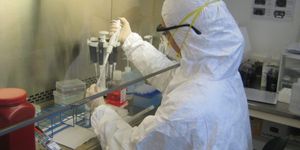Tumor-Highlighting Technology--Lights up Cells!
At the 56th Annual Meeting of The Society of Thoracic Surgeons, researchers announced the groundbreaking technology that can help enhance the visualization of cancer and giving an opportunity for clinicians to accurately find and remove cancerous tissues. The tumor-highlighting technology, referred to as ‘OTL38’, was demonstrated on lung cancer tissue during the clinical studies.
“Lung cancer is the most common and lethal cancer worldwide,” said Inderpal (Netu) S. Sarkaria, MD, from the University of Pittsburgh Medical Center in Pennsylvania. “Technologies to improve the care of these patients are needed. Near-infrared imaging with OTL38 during surgery for lung cancer is one such promising technology with the potential to significantly improve the completeness and quality of the operation, therefore improving patient outcomes.”
Learn more about lung cancer:
During phase 2 of the clinical trial, 92 patients with lung lesions received intravenous dose of OTL38 before undergoing operation involving pulmonary resection for non-small cell lung cancer (NSCLC). OTL38 consists of near-infrared dye and a targeting molecule that attaches to folic-acid-based receptors on the cancer cells. When attached, the targeted florescent marker ‘illuminates’ during surgery using an endoscope.
“OTL38 is the first technique that is specific to imaging adenocarcinomas of the lung, which is one of the most common types of invasive lung cancer, making it unique and clinically useful in this respect,” said Dr. Sarkaria. “Localization of tumors, identification of occult tumors, and immediate tumor margin assessment during surgery for adenocarcinomas of the lung were significantly improved with the use of this technology.”
OTL38 was used to improve molecular imaging outcomes by identifying hard-to-detect cancer lesions that need to be surgically removed. Traditionally, oncologists opted to use X-rays, magnetic resonance imaging, computed tomography (CT) scans, positron emission tomography, and/or ultrasound devices to help them size and locate tumors before operating. But, these methods were rarely used during operation. Thus, OTL38 may be the first method utilized by surgeons to provide a unique benefit—targeting cancerous tissue in real-time.
“Near-infrared imaging with OTL38 may be a powerful tool to help surgeons significantly improve the quality of lung cancer surgery by more clearly identifying tumors and allowing the surgeon to better see and completely remove them—one of the most vital components in the overall care of patients with this disease,” said Dr. Sarkaria. “Use of advanced near-infrared imaging techniques such as OTL38 may provide surgeons with powerful tools to improve the quality of lung cancer operations by better identifying small, hard-to-find tumors, finding previously undetected cancers at the time of surgery, and better assessing if the entire tumor has been removed.”
Source: The Society of Thoracic Surgeons










